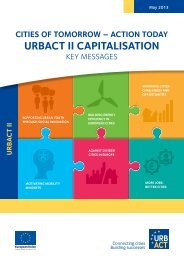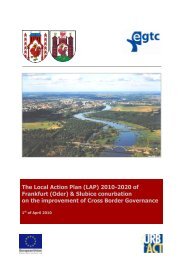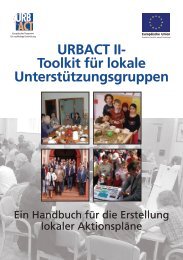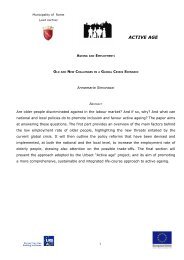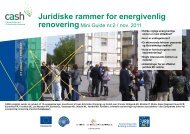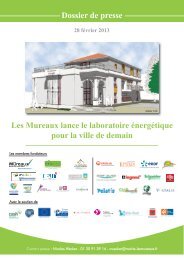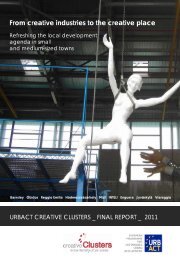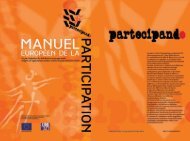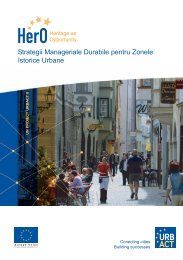ENTER.HUB_Baseline study PDF, 6 Mo - Urbact
ENTER.HUB_Baseline study PDF, 6 Mo - Urbact
ENTER.HUB_Baseline study PDF, 6 Mo - Urbact
Create successful ePaper yourself
Turn your PDF publications into a flip-book with our unique Google optimized e-Paper software.
EUROPEAN<br />
UNION<br />
European Regional<br />
Development Fund<br />
<strong>ENTER</strong>.<strong>HUB</strong> AIMS:<br />
to DEVELOP A WELL BALANCED POLYCENTRIC SYSTEM: to make these medium cities attractive<br />
and competitive; to address the existing hierarchies among the cities and the preferential<br />
connections before and after the arrival of a intermodal hub, the TEN-T corridors and HSL; to<br />
carry an equal re-distribution of the urban weights and a re-definition of the urban centre<br />
systems; to maintain an equilibrium of the urban and rural contexts by working on their<br />
peculiar identity, strengthening effective connections but avoiding shrinking or dispersion<br />
phenomena.<br />
to INTERVENE AT DIFFERENT LOCAL LEVELS (starting form cities, because they are “engines”<br />
of the territorial development):<br />
a-- the LOCAL level of the station area and of the city itself (i.e. relations with the historical<br />
city centre; measures for avoiding the urbanized areas dispersion, especially in the cases of<br />
decentralized stations). For example, in-depth studies at EU level have highlighted that the<br />
arrival of a HSL, livening up the internal dynamics and bringing an image of a really European<br />
and “open-minded” city, can give a great development push to the city and to all the spheres<br />
of the economy<br />
b-- the REGIONAL level of the territories gravitating on each of these new railway hubs: how<br />
making the station accessible and regenerating for the whole catchment area; how spreading<br />
the HS and railway EU corridors effects on the whole influence area.<br />
c-- the EUROPEAN level of all the EU territories connected by these preferential channels, to<br />
be perceived as infrastructural and relation channels: how to foster these relationships in<br />
order to create a new EU exchange network for the sharing of economical-social-cultural<br />
flows able to face the crisis. This will revitalise the rail transport on the medium/long<br />
distances too (it has been pointed out that for distances up to 600 km the HS train is<br />
competitive with the plane).<br />
to make cities able to reach the difficult BALANCE among some variables like GROWTH,<br />
EQUITY, ENVIRONMENTAL QUALITY, LOCAL IDENTITY, in order to face the current economical<br />
crisis;<br />
to bring COHESION AND VALORISATION on the internal RESOURCES-identities-heritages, being<br />
them at the basis of the economical and social development : protection from the<br />
homologation risks; protection of the differences of the EU territories; keeping of the<br />
capacity of producing growing parts of territorial added value; establishment of a high quality<br />
in the fields of urban design, architecture and environment.<br />
to promote the EQUITABLE CONDITIONS OF ACCESSIBILITY in terms of infrastructures for the<br />
whole European territory (not only in terms of extension but even of density).<br />
<strong>ENTER</strong>.<strong>HUB</strong> <strong>Baseline</strong> <strong>study</strong> 2012.10.31<br />
67



